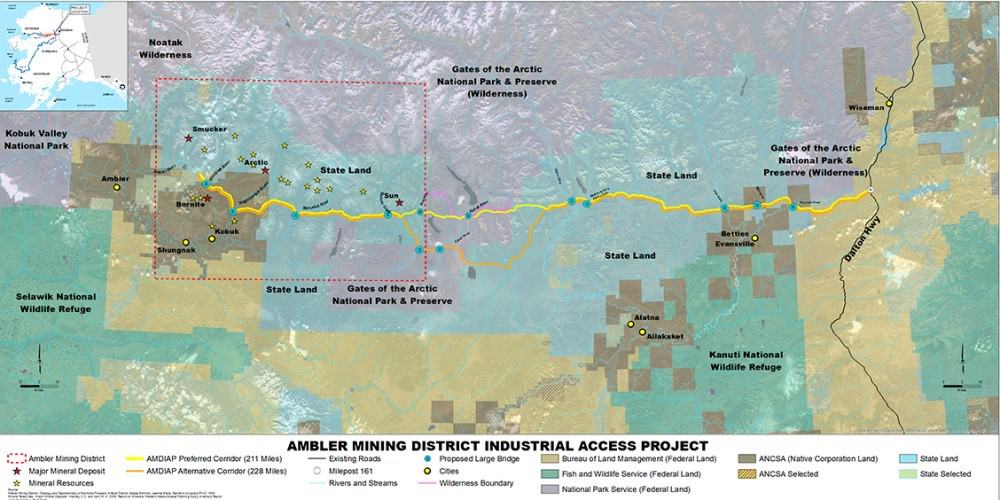Trump's Alaska Mining Road: A Path to AI Dominance
Trump revives the controversial Ambler Mining Road to access AI-critical minerals, sparking debates on environmental and indigenous impacts.

Trump Revives Controversial Alaska Mining Road to Boost AI-Related Minerals Industry
Former President Donald Trump has reignited a contentious debate by approving the construction of a 211-mile industrial road through Alaska’s pristine wilderness to facilitate mining of critical minerals essential for advanced technologies, including artificial intelligence (AI). This project, known as the Ambler Mining Road, aims to unlock vast deposits of copper, cobalt, gold, and other metals in the Ambler Mining District, a remote area north of Fairbanks, Alaska. The move, announced in October 2025, represents a significant shift in U.S. policy towards domestic mineral extraction with implications for national security, economic growth, and environmental conservation.
Background and Project Details
The Ambler Mining Road was initially approved during Trump’s first presidential term but was later blocked by the Biden administration due to environmental concerns and the potential adverse impact on Alaska Native communities, which depend on the region for hunting and fishing. The road would cut through parts of the Gates of the Arctic National Park, one of the last untouched landscapes in the United States, raising alarms among conservationists and indigenous groups.
Trump’s October 2025 directive reauthorizes permits for the project, ordering the Bureau of Land Management, National Park Service, and U.S. Army Corps of Engineers to issue the necessary approvals. The administration argues that the road is in the public interest, citing the strategic importance of domestic critical minerals supply, especially for emerging technologies such as AI, electric vehicles, and renewable energy.
Strategic Importance for AI and National Security
Interior Secretary Doug Burgum emphasized that the mining road and related investments are vital to securing minerals needed to "win the AI arms race against China," a country that currently dominates the processing of many vital metals. The U.S. government is also taking a direct stake in this strategic sector by investing $35.6 million for a 10% equity interest in Trilogy Metals, the Canadian company developing the Ambler site. This partnership includes warrants to purchase an additional 7.5% of the firm, signaling a strong federal commitment to domestic mining infrastructure.
Trilogy Metals’ CEO Tony Giardini described the partnership as a "significant milestone" for establishing a secure, domestic supply chain for critical minerals. He underlined the project's alignment with U.S. priorities in energy, technology, and national defense, especially under the newly rebranded Department of War, reflecting the heightened strategic stakes involved.
Environmental and Indigenous Concerns
Opposition to the project remains fierce. Environmental groups and Alaska Native tribes warn that the road and mining activities could irreversibly disrupt ecosystems, threaten caribou herds, and undermine subsistence lifestyles. The Gates of the Arctic region is one of the most ecologically sensitive and culturally significant parts of Alaska. Critics argue that the Biden administration’s previous blocking of the road was justified to protect these values against short-term economic interests.
The Biden administration had framed its decision as a defense of Alaska’s environmental integrity and indigenous sovereignty. However, the Trump administration’s latest move frames the road as essential to "America’s national defense and economic prosperity," emphasizing mineral independence amid global supply chain vulnerabilities.
Economic and Industrial Impact
The new mining road is expected to unlock billions of dollars’ worth of minerals, boosting U.S. capability to produce copper, cobalt, and lithium—key components for AI hardware, batteries, and other advanced technologies. The project is part of a broader strategy to reduce U.S. dependence on foreign sources, particularly China, which currently controls large portions of the global critical minerals supply chain.
Alongside the Ambler project, the U.S. government has also taken stakes in other critical mineral ventures, such as Lithium Americas’ Thacker Pass lithium mine in Nevada, further underscoring a national push toward domestic resource development.
Visual Illustrations
- Map and satellite imagery showing the proposed 211-mile Ambler Mining Road corridor cutting through Alaska’s wilderness and the Gates of the Arctic National Park.
- Photographs of the Ambler Mining District, highlighting mineral-rich landscapes with copper and cobalt deposits.
- Official logos of Trilogy Metals and the U.S. Department of the Interior, representing the public-private partnership.
- Portraits of Donald Trump and Interior Secretary Doug Burgum, emphasizing leadership roles in the project’s revival.
The reopening of the Ambler Mining Road project marks a pivotal moment in U.S. resource policy, balancing economic and technological imperatives against environmental stewardship and indigenous rights. As AI and clean energy technologies advance rapidly, securing domestic sources of critical minerals is increasingly viewed as a national security priority, even as debates over conservation and indigenous sovereignty intensify.



